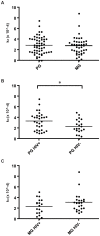Differential recognition of P. falciparum VAR2CSA domains by naturally acquired antibodies in pregnant women from a malaria endemic area
- PMID: 20169064
- PMCID: PMC2821912
- DOI: 10.1371/journal.pone.0009230
Differential recognition of P. falciparum VAR2CSA domains by naturally acquired antibodies in pregnant women from a malaria endemic area
Abstract
Background: Plasmodium falciparum infected red blood cells (iRBC) express variant surface antigens (VSA) of which VAR2CSA is involved in placental sequestration and causes pregnancy-associated malaria (PAM). Primigravidae are most susceptible to PAM whereas antibodies associated with protection are often present at higher levels in multigravid women. However, HIV co-infection with malaria has been shown to alter this parity-dependent acquisition of immunity, with more severe symptoms as well as more malaria episodes in HIV positive women versus HIV negative women of a similar parity.
Methods: Using VAR2CSA DBL-domains expressed on the surface of CHO-745 cells we quantified levels of DBL-domain specific IgG in sera from pregnant Malawian women by flow cytometry. Dissociations constants of DBL5epsilon specific antibodies were determined using a surface plasmon resonance technique, as an indication of antibody affinities.
Results: VAR2CSA DBL5epsilon was recognized in a gender and parity-dependent manner with anti-DBL5epsilon IgG correlating significantly with IgG levels to VSA-PAM on the iRBC surface. HIV positive women had lower levels of anti-DBL5epsilon IgG than HIV negative women of similar parity. In primigravidae, antibodies in HIV positive women also showed significantly lower affinity to VAR2CSA DBL5epsilon.
Conclusions: Pregnant women from a malaria-endemic area had increased levels of anti-DBL5epsilon IgG by parity, indicating this domain of VAR2CSA to be a promising vaccine candidate against PAM. However, it is important to consider co-infection with HIV, as this seems to change the properties of antibody response against malaria. Understanding the characteristics of antibody response against VAR2CSA is undoubtedly imperative in order to design a functional and efficient vaccine against PAM.
Conflict of interest statement
Figures




Similar articles
-
Insight into antigenic diversity of VAR2CSA-DBL5ε domain from multiple Plasmodium falciparum placental isolates.PLoS One. 2010 Oct 1;5(10):e13105. doi: 10.1371/journal.pone.0013105. PLoS One. 2010. PMID: 20957045 Free PMC article.
-
Differential evolution of anti-VAR2CSA- IgG3 in primigravidae and multigravidae pregnant women infected by Plasmodium falciparum.Malar J. 2008 Jan 11;7:10. doi: 10.1186/1475-2875-7-10. Malar J. 2008. PMID: 18190692 Free PMC article.
-
The antibody response of pregnant Cameroonian women to VAR2CSA ID1-ID2a, a small recombinant protein containing the CSA-binding site.PLoS One. 2014 Feb 4;9(2):e88173. doi: 10.1371/journal.pone.0088173. eCollection 2014. PLoS One. 2014. PMID: 24505415 Free PMC article.
-
VAR2CSA and protective immunity against pregnancy-associated Plasmodium falciparum malaria.Parasitology. 2007;134(Pt 13):1871-6. doi: 10.1017/S0031182007000121. Parasitology. 2007. PMID: 17958922 Review.
-
Progress and Insights Toward an Effective Placental Malaria Vaccine.Front Immunol. 2021 Feb 25;12:634508. doi: 10.3389/fimmu.2021.634508. eCollection 2021. Front Immunol. 2021. PMID: 33717176 Free PMC article. Review.
Cited by
-
Malaria during Pregnancy.Cold Spring Harb Perspect Med. 2017 Jun 1;7(6):a025551. doi: 10.1101/cshperspect.a025551. Cold Spring Harb Perspect Med. 2017. PMID: 28213434 Free PMC article. Review.
-
Antibody levels to recombinant VAR2CSA domains vary with Plasmodium falciparum parasitaemia, gestational age, and gravidity, but do not predict pregnancy outcomes.Malar J. 2018 Mar 9;17(1):106. doi: 10.1186/s12936-018-2258-9. Malar J. 2018. PMID: 29523137 Free PMC article.
-
Comparison of the specificity of antibodies to VAR2CSA in Cameroonian multigravidae with and without placental malaria: a retrospective case-control study.Malar J. 2015 Dec 1;14:480. doi: 10.1186/s12936-015-1023-6. Malar J. 2015. PMID: 26626275 Free PMC article.
-
Designing a VAR2CSA-based vaccine to prevent placental malaria.Vaccine. 2015 Dec 22;33(52):7483-8. doi: 10.1016/j.vaccine.2015.10.011. Epub 2015 Nov 26. Vaccine. 2015. PMID: 26469717 Free PMC article. Review.
-
Functional Antibodies against Placental Malaria Parasites Are Variant Dependent and Differ by Geographic Region.Infect Immun. 2019 Jun 20;87(7):e00865-18. doi: 10.1128/IAI.00865-18. Print 2019 Jul. Infect Immun. 2019. PMID: 30988054 Free PMC article.
References
Publication types
MeSH terms
Substances
Grants and funding
LinkOut - more resources
Full Text Sources
Miscellaneous

